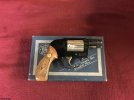Petrol & Powder
Well-Known Member
Back in the day (how’s that for a non-descript time frame) but starting around 1969, Smith & Wesson produced a special run of Model 38 revolvers with stainless steel cylinders. These were delivered to Michigan Police Supply and reported to be a special order for the Michigan State Police as issued backup guns. The guns are typical S&W model 38 J-frames with alloy frames (Bodyguard Airweight, 1 7/8” barrel) BUT have stainless steel cylinders fitted. So, the finish is a combination of black anodized aluminum (frame), blued steel (barrel, ejector rod, trigger, thumbpiece, etc.) and stainless steel (cylinder).
What was the purpose of that stainless steel cylinder? If it was for rust-resistance, then why have the carbon steel barrel, ejector rod, trigger, etc.?
Was it for identification? Was it just a fluke to be unique with no purpose?

Image stolen from internet
What was the purpose of that stainless steel cylinder? If it was for rust-resistance, then why have the carbon steel barrel, ejector rod, trigger, etc.?
Was it for identification? Was it just a fluke to be unique with no purpose?

Image stolen from internet
